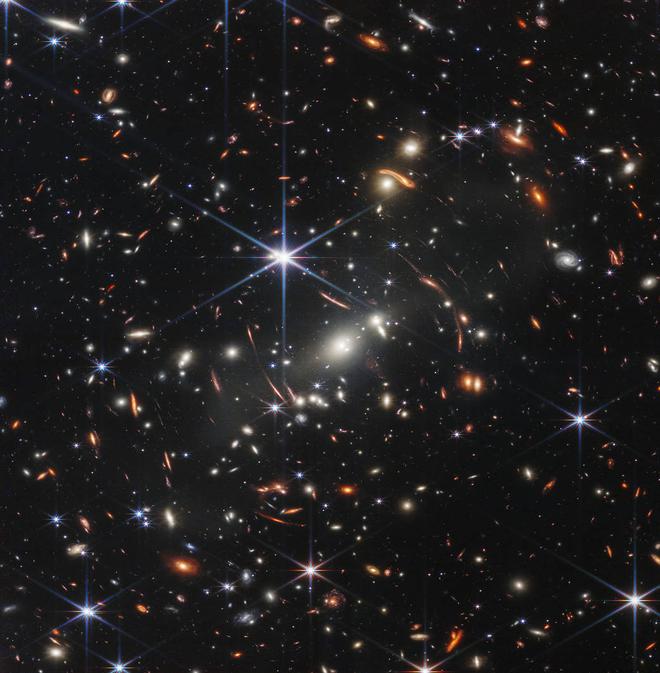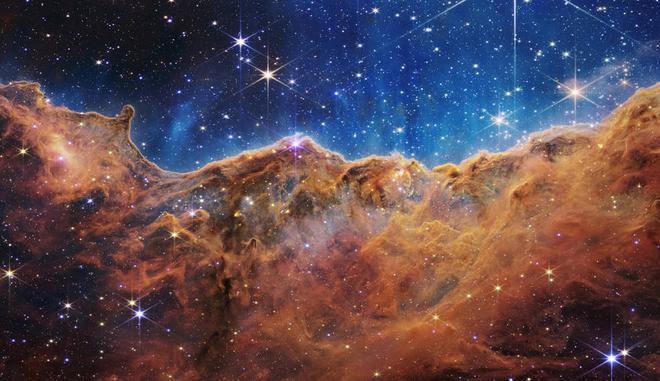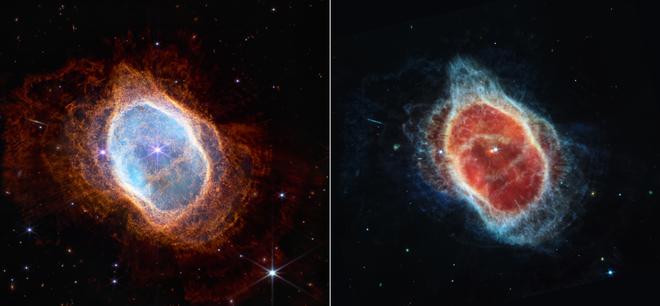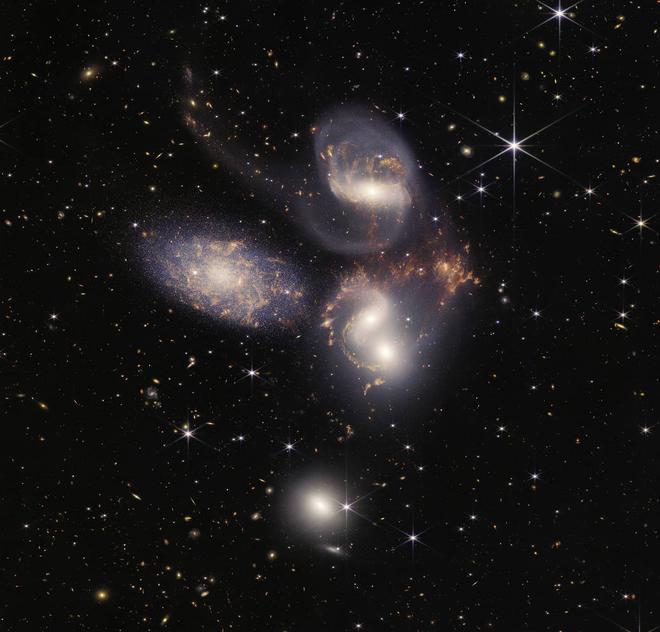On November 30, 1609, Galileo turned his telescope towards the night sky. This singular act revolutionised astronomy. Until then, scholars held that celestial objects were without any kind of blemish. Galileo showed that the Moon had craters and mountains. All celestial objects, including stars, were thought to go around the Earth. The telescope, by observing phases of Venus firmly established that planets go around the Sun and not the Earth. The Milky Way, a haze in the dark night teemed with hundreds of stars, established that the cosmos is immense and beyond our imagination. Galileo revolutionised astronomy using a crude telescope which by today's standards is merely a toy.
The first five images released by NASA (National Aeronautics and Space Administration) on July 11, captured by the James Webb Space Telescope (JWST) is no less momentous in the history of astronomy than the day Galileo turned his telescope toward the heavens.
The deep field image of the SMACS 0723 cluster of galaxies has images that date back to times when the first stars were born. The images from Carina Nebula vividly show the birth of new stars. In contrast, the Southern Ring Nebula image details a dying star. In Stephan's quintet, the JWST has captured the cataclysmic cosmic collision of galaxies. By analysing the spectrum of the radiation from WASP-96 b, an exoplanet (a planet orbiting a distant star), the telescope has shown conclusively the presence of water vapour in the atmosphere of this hot, puffy gas giant planet orbiting a distant Sun-like star. With its sharp vision, more light-collecting area and ability to see in the invisible infrared regions, the JWST is sure to expand our understanding of the cosmos.
Peering back in time
About 13.8 billion years ago, through the Big Bang, our Universe emerged. The first stars and galaxies were born around 300 million years after the Big Bang. To know more about the formation of these stars and galaxies, we do not need a time machine or time travel. As light travels with a velocity of about 3,00,000 km per second, light from a distant object will take time to reach us on Earth. Hence, when we see a distant stellar object, we see it as if it were far back in time. Powerful telescopes are therefore, like time machines.
However since objects far away are dim, we need giant telescopes to collect more light. Further, light from distant objects is stretched out by the expansion of our Universe, driving the radiation from the visible range into the infrared. Therefore, to look deep back into the early phases of the Universe, we need a giant infrared telescope. JWST is the biggest infrared telescope ever built. With a 6.5-metre primary mirror, the JWST infrared telescope collects more photons than Hubble. It can see even the faintest flicker from the most distant regions of the cosmos.
Cluster of galaxies
The SMACS 0723 is a noted cluster of galaxies around 5.12 billion light-years away. Situated in the direction of the southern constellation of Volans, the image is as it appeared 4.6 billion years ago, about the same time when the Sun and the Earth evolved. The cluster has been previously studied by Hubble, Planck and Chandra space telescopes. But the rich details and features of the JWST's Near-Infrared Camera (NIRCam) are unmatched.

With a sharper vision than Hubble, many of the galaxies seen clearly in this image appear as mere blobs in Hubble's telescope. SMACS 0723 galaxy cluster is massive, which, as Einstein's general relativity theory predicts, distorts the fabric of spacetime. Like the refraction of a ray of light passing through a lens, the light from behind bends through the massive cluster. Due to this ''gravitational lensing'' effect, we notice that some galaxies appear distorted in an arc shape, some are split into multiple images, and some are magnified.
The kaleidoscope of colours in the image captured by the JWST's Mid-Infrared Instrument (MIRI) are false colours (false colour refers to colour rendering methods used to display images which were recorded in the visible or non-visible parts of the electromagnetic spectrum, in colour) corresponding to a radiation wavelength. Galaxies that appear blue in this image contain stars but very little dust. The cosmic objects enveloped by dust appear red. Objects rich in hydrocarbons and other chemical compounds are green.
“A couple of galaxies are found to be at a redshift of eight, corresponding to a lookback time of ~ 13.0 billion years, a mere ~800 million years after the Big Bang. These are some of the oldest galaxies ever known” says Manoj Puravankara, Dept. of Astronomy and Astrophysics, Tata Institute of Fundamental Research, Mumbai.
Where stars are born
Stars and star clusters are formed inside giant gas clouds. Typically the massive interstellar clouds where new stars are formed are huge with diameters of about 100 light-years and holding nearly six million solar masses. There is enough material for making hundreds of stars out of this. Nonetheless, the density of these clouds is just 100 atoms per cubic centimetre. Stars typically have about 10^22 (one followed by 22 zeros) atoms per cubic centimetre. While various theories explain how the dispersed mass aggregate and stars evolve, hard evidence is still lacking. The visible light is obscured by the thick dust that goes into the making of these stars and render it opaque. Shrouded in thick dust clouds, these star forming regions remained hidden to even powerful telescopes, until now.
One such stellar nursery booming with new stars is a giant interstellar gas cloud in our galaxy called NGC 3324, located in the direction of the Carina Nebula. The stunning image of an edge of the NGC 3324, dubbed Cosmic Cliff, located approximately 7,600 light-years from Earth, is home to many massive and young stars than our Sun. With the giant gas cloud condensing into new stars, this is an active star-forming region. Hot gas and dust emit infrared light. By steering its NIRCam and MIRI instruments into the highly-dense dust clouds, the JWST has revealed rich details of this star formation region.

The striking image shows many exciting features in the innards of the star-forming regions. Hundreds of baby stars, previously invisible to telescopes, shine through the dust cloud. Thin gas pervades the space between the stars called the interstellar medium. When the infant stars begin to shine, they blow away the interstellar matter. The region devoid of gas appears in the image in the shape of bubbles and cavities. The mountains and valleys in the interstellar medium shaped by the radiation from the budding stars are visible, while the stars located in the centre of the bubble are off the frame. Other phenomena that one sees in the image include ionised gas and hot dust wafting away due to radiation from young stars, casing turbulence and eddies and dust swirling in the surrounding gas. What appears as a golden comet in this image are actually jet outflows from the newborn stars.
Two Indian astronomers are slated to use the JWST data to study star formation. Manoj Puravankara will be using the data obtained from Near Infrared Spectrograph (NIRSpec) and MIRI instruments to study the earliest phases of star formation, that is the protoplanetary disks — the birthplaces of planetary systems. “JWST's unprecedented sensitivity, angular resolution, and spectral resolution allow us to study various mass flows that shape and regulate the formation of stars and planetary systems” he says.
Jessy Jose, Assistant Professor from the Department of Physics, IISER Tirupati will be part of an international collaboration to study the very massive, dense molecular cloud within the central molecule zone of our Milky Way in order to understand the young stellar objects within it. “The NIRcam and MIRI instruments of JWST which broadly covers the wavelength range from 0.6 to 28-micron meter will enable us to characterise the very early phase of star formation” she says.
A star on its deathbed
The Eight-Burst Nebula, also known as the Southern Ring Nebula or NGC 3132, is a well-known planetary nebula in the constellation Vela, located approximately 2,500 light-years from Earth.

Despite their name, planetary nebulae have nothing to do with planets. They are gas shells formed from the cast-off outer layers of a dying star. Intermediate mass stars with a mass of 0.8 to eight times the mass of the Sun end their lives with drama. They do not die in one big explosion but go through a cycle of fits and starts. The dying star will expel its outer layer and expand, while simultaneously, its core will contract. The contracting centre will once again start to emit energy, and the star will have a lease of life. The expelled shell is pushed by this radiation and expands in space like a ring around the central star. After some time, the central star again sheds its outer layer while the remaining core contracts. Over time successive waves of expelled outer shells surround the central star-like concentric rings. The remaining core of the star ultimately becomes a faint glowing white dwarf. After trillions of years, they cool down and no longer shine, ultimately becoming black dwarfs. The near-infrared light is false coloured blue, and the mid-infrared light is red in this impressive image by the JWST. The consecutive waves of expelled shells can be clearly seen. If you look closely at the central region, a redder star shining next to a bright blue one can be seen. Astronomers knew that the Southern Ring Nebula was a binary star system. For the first time, we can clearly see the second star hidden behind the dust clouds.
Out Sun, an intermediate-mass star, will undergo a similar fate.
Cosmic waltz
Situated in the direction of the constellation Pegasus, around 290 million light-years away from Earth, is the clutch of five galaxies, each bound with the other called the Stephan's Quintet. Four of these close-knit galaxies are in a sort of dangerous waltz dance. Two of them are currently in the process of merging into one another. Studying such cataclysmic galactic interactions will help us understand how these lead to star formation, evolution, and central black holes in galaxies.

Hunt for the extra-terrestrial
Located around 1,150 light-years from Earth, WASP-96b is an exoplanet (a planet that orbits another star) orbiting a star named WASP-96. The planet has a mass half that of Jupiter and goes around the central star every 3.4 days. The light from the central star will pass through the planet's atmosphere when its edge is in the line of sight of the Earth. The molecules present in the atmosphere will first absorb the light entering the atmosphere. Then it would be remitted. By comparing the star's spectrum and the starlight passing through the planet's atmosphere, astronomers can discern the molecular composition. The spectroscopic observation of JWST reveals, for example, that there is a considerable amount of water vapour in the WASP-96 b's atmosphere.

With blistering heat, WASP-96 is unlikely to host life; However, astronomers will use the same technique to examine other exo-planets, particularly those in the habitable zone of the central star. Finding water vapour, hydrocarbons, methane, and other atmospheric elements could indirectly indicate life.
T.V. Venkateswaran is Scientist at Vigyan Prasar, Dept of Science and Technology
!["[T]he First and Fifth Amendments Require ICE to Provide Information About the Whereabouts of a Detained Person"](https://images.inkl.com/s3/publisher/cover/212/reason-cover.png?w=600)






